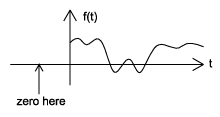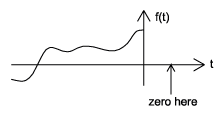| << Chapter < Page | Chapter >> Page > |
This module will lay out some of the fundamentals of signal classification. This is basically a list of definitions andproperties that are fundamental to the discussion of signals and systems.
Along with the classification of signals below, it is also important to understand the Classification of Systems .
As the names suggest, this classification is determined by whether or not the time axis (x-axis) is discrete (countable) or continuous . A continuous-time signal will contain a value for all real numbers along the time axis.In contrast to this, a discrete-time signal is often created by using the samplingtheorem to sample a continuous signal, so it will only have values at equally spaced intervals along the timeaxis.

The difference between analog and digital is similar to the difference between continuous-time and discrete-time. In this case, however,the difference is with respect to the value of the function (y-axis) ( [link] ). Analog corresponds to a continuous y-axis, while digital corresponds to a discretey-axis. An easy example of a digital signal is a binary sequence, where the values of the function can only be oneor zero.

Periodic signals repeat with some period , while aperiodic, or nonperiodic, signals do not. We candefine a periodic function through the following mathematical expression, where can be any number and is a positive constant:


Causal signals are signals that are zero for all negative time, while anticausal are signals that are zero for all positive time. Noncausal signals are signals that have nonzero values in both positive and negative time ( [link] ).



An even signal is any signal such that . Even signals can be easily spotted as they are symmetric around the vertical axis. An odd signal , on the other hand, is a signal such that ( [link] ).


Using the definitions of even and odd signals, we can show that any signal can be written as a combination of an even andodd signal. That is, every signal has an odd-even decomposition. To demonstrate this, we have to look nofurther than a single equation.




A deterministic signal is a signal in which each value of the signal is fixed and can be determined by amathematical expression, rule, or table. Because of this the future values of the signal can be calculated from pastvalues with complete confidence. On the other hand, a random signal has a lot of uncertainty about its behavior. The future values of a random signal cannot beaccurately predicted and can usually only be guessed based on the averages of sets of signals.


A
right-handed signal and
left-handed signal are those signals whose
value is zero between a given variable and positive ornegative infinity. Mathematically speaking, a right-handed
signal is defined as any signal where
for
, and a left-handed signal is defined as any signal where
for
. See (
[link] ) for an example. Both
figures "begin" at
and then extends to positive or negative infinity
with mainly nonzero values.


As the name applies, signals can be characterized as to whether they have a finite or infinite length set ofvalues. Most finite length signals are used when dealing with discrete-time signals or a given sequence of values.Mathematically speaking, is a finite-length signal if it is nonzero over a finite interval where and . An example can be seen in [link] . Similarly, an infinite-length signal , , is defined as nonzero over all real numbers:


Notification Switch
Would you like to follow the 'Principles of digital communications' conversation and receive update notifications?